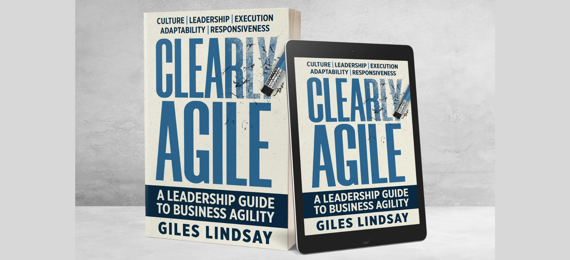
Agile businesses embrace change rather than dread it, and harness its power to drive success.
In a constantly evolving business environment you must adapt and respond in order to survive. Clearly Agile explains how the agile approach created for tech development has been woven into every aspect of businesses such as Amazon, Spotify, and Netflix to not only enable them to survive but to innovate and thrive. It introduces a framework that aims to guide your organisation towards business agility.
We've built our business processes on the agile approach so we were really curious to read this book to discover how we measure up and what we can learn to support our clients on their innovation journey.
In summary it's a great book, packed full of theory backed up with evidence and real life examples. If you're a leader in a business using the more traditional management approaches but curious how you can stay competitive in the current economic climate you'll get a lot out of it. It's written so that you can dip into different chapters and still gain a grasp of the basics so beware if you read it cover to cover it can get a bit repetitive. If you are new to agile there are sections that give you a good overview of the basics - if you are already quite well acquainted with agile you'll probably want to skip those. There's some really good insight on creating a culture that facilitates the innovation of new ideas. So regardless of whether you are a startup founder or a leader in a large organisation this is really useful stuff.
About the author
Giles Lindsay is currently CEO of Agile Delta Consulting - a global agile consultancy and coaching business. He has over 25 years experience in the tech industry and has lead digital transformation initiatives and delivered innovative software solutions.
What is the book about?
The book is centred on the CLEAR Model - a framework or 'Faithful Compass' to guide organisations towards agility. The key components of the model are Culture, Leadership, Execution, Adaptability and Responsiveness.
The 5 sections of the book talk you through the need for business agility, how to create an agile culture, and nurture agile leaders and teams. Everything is linked back to the CLEAR Model.
The CLEAR Model:
- Culture: Values and behaviours within the organisation
- Leadership: Capacity of leaders to inspire and guide
- Execution: Skills and tools to put strategy into action
- Adaptability: Ability to alter structures and operations
- Responsiveness: Reactivity to emerging customer or market needs
Throughout the book, theory is backed up with data and illustrated through real life examples, as well as 'how to' sections at the end of chapters - breaking down how to achieve agile transformation into smaller achievable steps (typically agile!).
The main message is that there is not a 'one size fits all' approach. The CLEAR model is very much a framework which you as a business must tailor to serve the needs of your organisation. It acts as a 'Faithful Compass' informing the direction but the route and obstacles to overcome on the journey will be unique to your business. Unfortunately copying Amazon’s agile framework won't necessarily guarantee your success.
Another key message is business agility is an attitude rather than a method. It talks about being agile rather than doing agile emphasising that it is a mindset rather than an application of methodology.
A common thread throughout the book is the importance of creating a culture of continuous learning where experimentation is valued, success is celebrated and failures seen as an opportunity for learning. All of these factors are critical to innovation.
Who is the book for?
If you are in a leadership role in an organisation that has traditional management approaches - this book is for you. It paints a picture of what an agile business looks like and explains how you can overcome the challenges on your transformation journey.
If you are a startup founder or small business owner wanting to build up a company with an agile culture at the core from the start - this book will give you some valuable insight and practical advice.
If you have very little agile knowledge you'll pick up some basics and a good overview of the different methods from the early chapters.
If you're curious how to bring a spirit of innovation to your team you'll benefit from reading this book. Agility is critical to innovation as it empowers teams to make decisions and act.
Is it any good?
Relevant
Today's businesses face fierce competition brought about by rapid technological innovations, unstable market conditions, and growing customer expectations. Traditional management approaches can't always respond effectively to these complexities. The book illustrates how agile offers a more flexible and customer centric approach that places your business in a position to thrive in current conditions.
Comprehensive
This book has theory backed up with data and brought to life through real life case studies. It even includes lists of questions to help you figure out your agile readiness and gives advice on how to fill in the gaps. Each chapter links back to the CLEAR framework and emphasises the benefits and nature of the agile approach. This means you can dip into parts or chapters and still get a complete understanding without having to read from cover to cover. The only negative of this is that if you do read it from cover to cover it can feel a little repetitive in parts. Also if you're already quite well versed on agile and its benefits you can skim over a fair bit of the content.
Practical
As well as case studies giving examples of big names who have embraced agile and thrived (e.g. Netflix, Spotify, and Amazon) and some who have not (e.g. Blockbuster, Wilko) the book also includes common challenges (e.g. resistance to change or difficulties in scaling Agile practices) and strategies for how you can over come them.
It also busts some common myths about agile such as 'it's just about coding', 'lacks structure', or it 'involves less planning than traditional approaches'. The explanations offer some clarity that could support your transition to agile.
If you're using more traditional management approaches and often struggle to respond effectively to changes in customer or market needs it's worth a read. It could be the difference between being Spotify or being Wilko!



